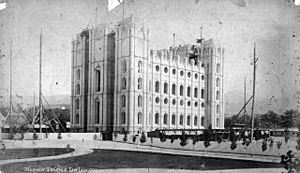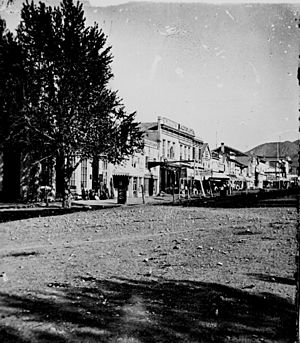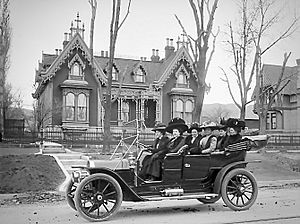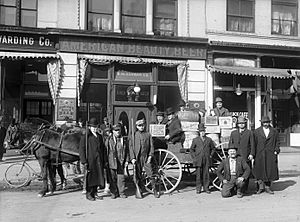History of Salt Lake City facts for kids
Originally, the Salt Lake Valley was home to several Native American tribes. These included the Shoshone, Paiute, Goshute, and Ute peoples. The Northwestern Shoshone tribe had seasonal camps along the streams in the valley. They called the Great Salt Lake Pi'a-pa ("big water") or Ti'tsa-pa ("bad water"). The United States government did not officially recognize the land rights of these tribes.
The first European explorer thought to have visited the area was Father Silvestre Vélez de Escalante in 1776. However, he only reached Utah Valley, south of Salt Lake City. The first American to see the Salt Lake area was Jim Bridger in 1824. Later, U.S. Army officer John C. Frémont surveyed the Great Salt Lake and the valley in 1843 and 1845.
A group of pioneers known as the Donner Party traveled through the Great Salt Lake Valley in 1846. They spent weeks cutting a difficult road through the Wasatch Mountains. This same path was later used by the first Mormon pioneers coming to Salt Lake.
Contents
Salt Lake City's Beginnings
On July 24, 1847, a group of 143 men, three women, and two children founded Great Salt Lake City. They settled a few miles east of the Great Salt Lake, nestled in the northern part of the Salt Lake Valley. The first two to enter the valley were Orson Pratt and Erastus Snow. These members of the Church of Jesus Christ of Latter-day Saints (often called the "LDS Church" or "Mormons") wanted to create a community where they could practice their religion freely. They were the first European settlers to live permanently in the area now known as Utah. Thousands more Mormon pioneers arrived in the following months and years.
Brigham Young led the Saints west after the death of their previous leader, Joseph Smith. When he arrived in the Salt Lake Valley, Young famously said, "It is enough. This is the right place. Drive on." This quote is often shortened to, "This is the place." Today, there is a state park in Salt Lake City called This Is The Place Heritage Park that marks the spot where Young made this statement.
Sadly, during the harsh winter of 1847, some Native Americans in the area died from an outbreak of measles.

Salt Lake City was founded by Latter-day Saint Pioneers to be a new religious community. Brigham Young first governed the area and the church through a High council. This group made the first rules for the city in 1848. Later, this system was replaced with a city council and a mayor, similar to how cities are governed today.
After a very difficult winter, the pioneers faced a cricket infestation that threatened their crops. They reported that seagulls miraculously saved their crops by eating the crickets. This event is known as the Miracle of the Gulls. The Salt Lake Valley then "blossomed as the rose." Early pioneers survived by working closely together. Under Young's leadership, they shared crops among the different communities established throughout the valley.
The California Gold Rush brought many people through Salt Lake City on their way to find gold. Salt Lake became an important trading spot for travelers. They brought goods from the East, like clothing and other manufactured items. They traded these with local farmers for fresh livestock and crops.
In 1850, the U.S. Congress created the Utah Territory from what was called the "State of Deseret." A few months later, on January 6, 1851, the city was officially named "The City of the Great Salt Lake." Initially, Fillmore, Utah was the capital of the territory. But in 1856, the capital moved to Salt Lake City, where it has been ever since.
In 1857, the U.S. government became concerned about the Mormon practice of polygamy (where a man has more than one wife). President James Buchanan sent an army of 2,500 soldiers, called the Utah Expedition, to investigate the LDS Church and appoint a new governor. In response, Brigham Young declared martial law (military rule). The Utah militia harassed the soldiers in a conflict known as the Utah War. Young eventually agreed to federal control when the new territorial governor, Alfred Cumming, arrived in Salt Lake City in 1858. Most troops left at the start of the American Civil War.
During the Civil War, more troops arrived in 1862 to protect the road to California. They settled in the Fort Douglas area, east of the city. Their leader, Colonel Patrick Edward Connor, did not like the LDS people. He encouraged mining to bring more non-LDS people to the area. In 1863, some of his troops found rich veins of gold and silver in the Wasatch Mountains.
In 1868, Brigham Young started the Zion's Co-operative Mercantile Institution (ZCMI). This was a way for the community to rely less on goods from outside Utah. ZCMI was a large store, sometimes considered one of the first department stores in the nation.
Change came quickly to Salt Lake City. In 1869, the First Transcontinental Railroad was completed north of the city at Promontory Summit. By 1870, Salt Lake was connected to it by the Utah Central Rail Road. People began to move to Salt Lake, looking for opportunities in mining and other industries.
The city government was controlled by the People's Party until 1890. This party was linked to the LDS Church, and early mayors of Salt Lake City were all LDS members. There were often disagreements between the LDS city government and federal authorities. For example, in 1874, city police were arrested by U.S. Marshals during an election. Mayor Daniel H. Wells declared martial law, but he was soon released.
In the 1880s, a law called the Edmunds-Tucker Act made it harder for many prominent LDS Church members to vote or hold office because of polygamy. People who practiced polygamy were held in a federal prison near the Sugar House area. As a result, the non-LDS Liberal Party gained control of the city government in the 1890 election. A few years later, both the Liberal Party and People's Party dissolved into national parties as Utah prepared to become a state. From then on, both LDS and non-LDS leaders would govern Salt Lake City.
Salt Lake City became Utah's state capital on January 4, 1896. This happened when Utah officially joined the United States after the LDS Church agreed to stop the practice of polygamy in 1890.
Salt Lake City in the 20th Century
In 1911, the city adopted a non-partisan city council. This meant that council members were not chosen based on political parties. As tensions between LDS and non-LDS groups eased, people began to work together. They improved roads, utilities, and public healthcare.
The Great Depression hit Salt Lake City very hard. At its worst, about 36% of the people were unemployed. The average income in 1932 was much lower than it had been a few years earlier. Jobs were scarce. Although federal programs and the LDS Church helped, the economy did not fully recover until World War II.
During World War II, Salt Lake's economy got a boost. Many defense industries moved to the Wasatch Front. The demand for raw materials increased Utah's mining industry. Several military bases, like Fort Douglas and Hill Air Force Base, were also added.
After the Second World War, Salt Lake City grew quickly. It started to face problems common in other growing cities. Urban sprawl (cities spreading out) became an issue because of fast growth and lots of available land. Military and aerospace industries also became very important.
Salt Lake City tried to host the Winter Olympics as early as the 1930s. However, these attempts failed. Salt Lake kept trying for decades until 1995. That year, the International Olympic Committee announced Salt Lake City as the host of the 2002 Winter Olympics.
After 132 years in business, ZCMI was sold in 1999. The remaining ZCMI stores, including the one downtown, became Meier & Frank stores. However, the old "1868 ZCMI 1999" sign still remains on the downtown building.
In 1999, the Salt Lake City council voted to sell a part of Main Street to the LDS Church for $8.1 million. This section was between Temple Square and the LDS Church office buildings. The Church planned to build a large plaza and parking garage there. There was some public concern about selling public land to a private organization. The ACLU argued that the restrictions on activities like demonstrations and skateboarding on the plaza were not fair. After some legal battles, the land became the Main Street Plaza, which is now fully owned by the LDS Church.
Salt Lake City Today
The 2002 Winter Olympics and Their Impact
The 2002 Winter Olympics brought many changes to the Wasatch Front area. There was a scandal when it was found that money had been used to influence members of the International Olympic Committee.
The Games Themselves
The games began with the 1980 U.S. hockey team lighting the torch. President George W. Bush officially opened the games at the Rice-Eccles Stadium. The closing ceremonies were also held there.
There was some controversy during the games. In the pairs figure skating competition, the French judge's scores were thrown out. The Canadian team of Jamie Salé and David Pelletier were then awarded a second gold medal. Some athletes in other sports were disqualified for various reasons, including doping. This led some countries to protest.
There were worries about terrorism after the September 11 attacks. However, the games proved to be safe.
The 2002 games ended with a spectacular closing ceremony. Bands like Bon Jovi and KISS performed. Most of the 2,500 athletes marched into Rice-Eccles Stadium.
What the Olympics Left Behind
Many improvements were made to the area's roads and transportation. Over $1.5 billion was spent on highway upgrades, including improvements to Interstate 15 through the city. New interchanges were built near Park City. A light rail system was built from downtown to the suburb of Sandy and later to the University of Utah.
The Athlete's Village, where the athletes stayed, is now student housing at the University of Utah. Many of the sports venues built for the games are still used today.
Many hotels, motels, and restaurants were built for the games. They continue to operate today.
Salt Lake City's Future
Salt Lake City is still figuring out its identity. It tries to balance being the center of a major religion and a modern, non-religious city. While founded by Mormons, the city is becoming more diverse. Its LDS population has been decreasing steadily since the 1990s.
Many changes are happening to the downtown area because of the area's huge growth. In the early 2010s, the LDS Church bought the Crossroads and ZCMI malls. They rebuilt them into the City Creek Center. This center has walkways and new residential and commercial buildings nearby.
The FrontRunner commuter rail system is in place along the northern Wasatch Front. There are plans to extend it to the southern part of the region. Extensions to the Trax light rail system are also happening. These will provide service to the western and southern parts of the valley, and to the Salt Lake City International Airport. A controversial highway, the Legacy Highway, has one part completed (the Legacy Parkway). The first phase of the next part, the Mountain View Corridor, has been finished through the west side of the Salt Lake Valley.
Images for kids










